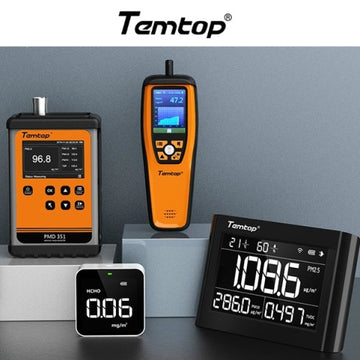Why PM2.5 Measurements Are Inaccurate: The Scientific Challenges of Air Pollution Monitoring
PM2.5 (fine particulate matter) is a major air pollutant affecting public health and environmental quality. Early science communication often described it as "spherical particles smaller than 2.5 micrometers." While this simplified analogy helped raise awareness, it may have also misled public understanding of pollution monitoring.
In reality, PM2.5 measurement involves complex scientific principles and technical limitations, leading to inherent uncertainties in the data. The tools we use to monitor it—including consumer-grade air quality monitors—face several scientific and technical challenges. That doesn’t mean these devices aren’t useful; it just means we need to interpret the data carefully.

1. PM2.5 Shape and Size: Not Just Tiny Spheres
The common analogy—"PM2.5 is 1/15 the width of a human hair"—suggests uniform spherical particles. However, real-world PM2.5 varies widely in morphology, appearing as flakes, chains, aggregates, or irregular clusters.
Key Concept: Aerodynamic Diameter
The "2.5 µm" in PM2.5 does not refer to physical size but to **aerodynamic diameter**, defined as:
The diameter of a unit-density (1 g/cm³) sphere that settles at the same speed as the particle in question.
This means:
- Denser particles (e.g., metals) may have a much smaller true diameter.
- Low-density particles (e.g., organic aerosols) may exceed 2.5 µm in actual size.
Conclusion: PM2.5 "size" is not fixed but depends on particle density and shape.
Tip: A high-quality air quality monitor equipped with accurate sensors accounts for aerodynamic behavior, not just raw size.
2. Sampler "Cutoff Efficiency": PM2.5 Is Not a Perfect Filter
PM2.5 samplers do not perfectly collect only particles ≤2.5 µm. Instead, they operate based on a 50% cutoff diameter (d₅₀ = 2.5 µm):
- 2.5 µm particles: Only ~50% are captured.
- Larger particles (e.g., 10 µm): Some (~10%) may still be collected.
- Smaller particles (e.g., 1 µm): A fraction (~90%) may be missed.
Different samplers have varying efficiency curves, making data comparisons challenging.
What This Means for You: Use your air quality monitor to track trends over time rather than focusing on minute-by-minute fluctuations.
3. Semi-Volatility: PM2.5 Is Not Stable
PM2.5 includes not only solid particles but also liquid droplets and volatile compounds (e.g., nitrates, organic carbon). During sampling:
- Losses: Volatile components may evaporate, underestimating mass.
- Gains: Gaseous pollutants (e.g., SO₂) may adsorb onto filters, overestimating mass.
Example: Quartz fiber filters may lose volatile organic compounds (VOCs) but absorb sulfuric acid vapors.
Why It Matters: Even with professional equipment, there’s a margin of uncertainty. Your home air quality monitor offers valuable insight—but it’s still estimating under dynamic conditions.

4. Nanoparticle "Penetration"
The lower size limit of PM2.5 extends to nanoparticles (e.g., from vehicle exhaust), which:
- Penetrate filters like gas molecules.
- Escape impactors due to negligible inertia.
This leads to underestimation of true concentrations.
Reality Check: If your monitor shows a "moderate" reading but you’re in traffic or near a smoky source, assume there’s more going on.
5. PM2.5 as a "Statistical Metric"
Due to these factors, PM2.5 concentrations are not absolute values but method-dependent estimates influenced by:
- Temperature & humidity
- sampler design
- Filter material
- Sampling duration
Implication: Data from different agencies or devices may not be directly comparable.
Key Takeaways: How to Interpret PM2.5 Data
- Avoid overinterpreting single measurements—focus on long-term trends.
- Acknowledge methodological biases when comparing datasets.
- Future improvements:
-
-
Standardized sampling protocols (e.g., humidity control).
-
Hybrid monitoring (real-time sensors + lab analysis).
-
Pro Tip: Choose an air quality monitor that allows long-term data tracking. This will give you better insight into your environment and help you make smarter lifestyle or ventilation choices.
6. Conclusion: Science Over Simplification
PM2.5 monitoring is a balance of science and engineering. In the era of big data, we must prioritize understanding limitations over chasing false precision. Only by embracing these complexities can we design effective policies—beyond just "hitting targets."
Making Sense of the Numbers: Use the Right Tool, the Right Way
Today’s smart air quality monitors bring high-resolution PM2.5 tracking to your fingertips. While they can't replace regulatory-grade stations, they’re invaluable for:
- Detecting pollution events early
- Monitoring indoor air quality
- Supporting long-term health awareness
Final Thoughts: Understanding Beats Precision
PM2.5 is a nuanced, evolving science. Instead of obsessing over individual numbers, aim to understand the trends, limitations, and context behind the data.
By pairing a reliable air quality monitor with informed interpretation, you can protect your health—and advocate for cleaner air—with confidence.
Product Link: https://www.temtop.co.uk/
References:
- U.S. EPA PM2.5 Monitoring Guidelines
- Research from Chinese Academy of Environmental Sciences


























